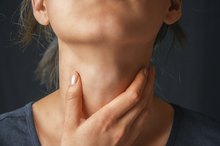Swollen Lymph Nodes Behind the Ears in Babies
Lymph nodes are intricately involved in your body's immune response, contributing to your ability to fight off infections. Located in various regions of your body -- including behind your ears -- nodes fill with fluid when you are exposed to a bacteria or virus. If your infant or young child experiences swollen lymph nodes, they may have been exposed to a pathogen 23. Contact your pediatrician for instructions and treatment options.
If you are experiencing serious medical symptoms, seek emergency treatment immediately.
The Lymphatic System
The lymphatic system is a network of vessels that carry a clear fluid called lymph, which contains protein molecules, salts and other substances, throughout your body 1. Acting as a drainage system, lymph vessels collect extra lymph fluid that leaks from body tissues and returns it to the blood. Without this process, the lymph fluid will cause tissue swelling. Bacteria and viruses are also drained out of cells and tissues through lymph fluid. Germs are filtered out in lymph nodes, which contain lymphocytes -- a type of white-blood cell -- to trap and destroy harmful invaders.
- The lymphatic system is a network of vessels that carry a clear fluid called lymph, which contains protein molecules, salts and other substances, throughout your body 1.
- Acting as a drainage system, lymph vessels collect extra lymph fluid that leaks from body tissues and returns it to the blood.
Swollen Lymph Nodes
A Sore Throat & Swollen Tonsils
Learn More
Lymph nodes are palpable, or able to be felt, and are typically less than 1/2 inch in diameter. During an infection, nodes may swell to over twice this size, according to Seattle Children's Hospital 2. Nodes that are 1/2 to 1 inch in size are indicative of a viral infection, while nodes greater than an inch in diameter are associated with a bacterial infection. Nodes in the neck and behind the ears are most often affected during childhood illness because of the respiratory infections that commonly affect children during this time. You may see or feel swellings behind the ears and along the back of the neck or under the jaw.
- Lymph nodes are palpable, or able to be felt, and are typically less than 1/2 inch in diameter.
Accompanying Symptoms
Swollen lymph nodes alone are not contagious; however, a potential infection is contagious 23. Accompanying symptoms like coughing, fever, irritability or a runny nose give greater clues as to the source of the infection. Lymph nodes can be painful, and the overlying skin can appear red. Swallowing and breathing can become impaired in certain cases.
- Swollen lymph nodes alone are not contagious; however, a potential infection is contagious 2.
- Lymph nodes can be painful, and the overlying skin can appear red.
Seeking Medical Care
What to Do for a 2 Year Old's Sinus Congestion
Learn More
Contact your doctor within 24 hours if a node is tender and 1 or more inches in size. If a fever is present or your child's movements are hindered by the swollen nodes, alert your physician. Treatment involves treating the underlying causes. If the infection is bacterial, your doctor may prescribe antibiotics. Viral infections do not respond to antibiotic treatment, so over-the-counter, anti-inflammatory medicines may be recommended by your pediatrician.
- Contact your doctor within 24 hours if a node is tender and 1 or more inches in size.
- If the infection is bacterial, your doctor may prescribe antibiotics.
Related Articles
References
- KidsHealth: Spleen and the Lymphatic System
- MayoClinic.com: Swollen Lymph Nodes
- Padera TP, Meijer EF, Munn LL. The Lymphatic System in Disease Processes and Cancer Progression. Annu Rev Biomed Eng. 2016;18:125-58. doi:10.1146/annurev-bioeng-112315-031200
- Lymph Nodes. National Cancer Institute.
- Cameron MH, Monroe L. Physical Rehabilitation for the Physical Therapist Assistant. Saunders. 2014.
- Fein MR, Egeblad M. Caught in the act: revealing the metastatic process by live imaging. Dis Model Mech. 2013;6(3):580-93. doi:10.1242/dmm.009282
- Miller LR. Lymphatic function and the immune response to microbial or viral infection. Lymphat Res Biol. 2013;11(3):116. doi:10.1089/lrb.2013.0010
- Swollen Lymph Nodes. Cleveland Clinic. 2019.
- Nasirian H, Tarvijeslami S, Matini E, Bayesh S, Omaraee Y. A clinical decision rule for streptococcal pharyngitis management: An update. J Lab Physicians. 2017;9(2):116-120. doi:10.4103/0974-2727.199635
- Bilal JA. Prevalence and Clinical Characteristics of Primary Epstein-Barr Virus Infection Among Children Presented with Cervical Lymphadenopathy. J Clin Diagn Res. 2015;9(7):SC08-10. doi:10.7860/JCDR/2015/13768.6265
- Swollen Lymph Nodes. Mount Sinai.
- Lymph Node Surgery for Breast Cancer. American Cancer Society. 2019.
- Chatterjee A, Serniak N, Czerniecki BJ. Sentinel lymph node biopsy in breast cancer: a work in progress. Cancer J. 2015;21(1):7-10. doi:10.1097/PPO.0000000000000090
- Scott S, Kitt B, Derenge D. Swollen lymph nodes · patient is otherwise "healthy" · Dx?. J Fam Pract. 2016;65(3):195-7.
- Fuso L, Varone F, Magnini D, Calvello M, Lo greco E, Richeldi L. Ultrasonography of the Mediastinum: Techniques, Current Practice, and Future Directions. Respir Care. 2018;63(11):1421-1438. doi:10.4187/respcare.06047
- Promer K, Pillay A, Chi KH, et al. A case of inguinal lymphogranuloma venereum imitating malignancy on CT imaging. Radiol Case Rep. 2019;14(5):581-583. doi:10.1016/j.radcr.2019.02.012
- Hale GR, Teplitsky S. Lymph node imaging in testicular cancer. Transl Androl Urol. 2018; 7(5): 864–874.
- Helbling R, Conficconi E, Wyttenbach M, et al. Acute Nonspecific Mesenteric Lymphadenitis: More Than "No Need for Surgery". Biomed Res Int. 2017;2017:9784565. doi:10.1155/2017/9784565
- Mao, Y., Hedgire, S., Prapruttam, D. et al. Imaging of Pelvic Lymph Nodes. Curr Radiol Rep. 2014;2(70). doi:10.1007/s40134-014-0070-z
- Mohseni S, Shojaiefard A, Khorgami Z, Alinejad S, Ghorbani A, Ghafouri A. Peripheral lymphadenopathy: approach and diagnostic tools. Iran J Med Sci. 2014;39(2 Suppl):158-70.
- Lymphadenitis. Johns Hopkins Medicine.
- Mazur-melewska K, Mania A, Kemnitz P, Figlerowicz M, Służewski W. Cat-scratch disease: a wide spectrum of clinical pictures. Postepy Dermatol Alergol. 2015;32(3):216-20. doi:10.5114/pdia.2014.44014
- What Is Breast Cancer?. American Cancer Society. 2019.
- Benaglio F, Vitolo B, Scarabelli M, et al. The draining lymph node in rheumatoid arthritis: current concepts and research perspectives. Biomed Res Int. 2015;2015:420251. doi:10.1155/2015/420251
- Kasper, Dennis L.., Anthony S. Fauci, and Stephen L.. Hauser. Harrison's Principles of Internal Medicine. New York: Mc Graw Hill education, 2015. Print.
- Kumar, Vinay, Abul K. Abbas, and Jon C. Aster. Robbins and Cotran Pathologic Basis of Disease. Philadelphia: Elsevier-Saunders, 2015. Print.
Writer Bio
Christy Callahan has been researching and writing in the integrative health care field for over five years, focusing on neuro-endocrinology. She has a Bachelor of Science degree in biology, earned credits toward a licensure in traditional Chinese medicine and is a certified Pilates and sport yoga instructor.








